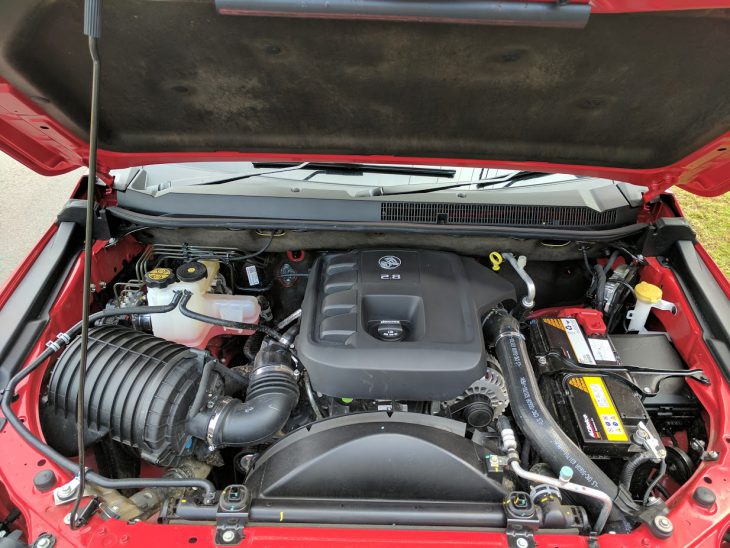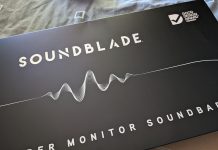I never thought I’d be the kind of guy to want to drive a utility … much less a journalist with the opportunity to take a giant red utility for a test drive and write a review about one. I mean, I drive a ute for work, but it’s a bog standard white Isuzu D-MAX single cab with a tray. It’s hardly exciting, but it gets the job done. By comparison, GM Holden’s 2017 Colorado Z71 is completely unhinged. Not only is it huge, but it’s bright red, it’s as comfortable as a car to drive, it goes like stink, and still has the capability to tow a horse float with a tonne of stuff in the load area.
In short, the Z71 is just a little bit nuts. It’s a ute, but it’s a ute that costs almost $60,000. You could use it as a workman’s vehicle, but why would you? It’s too nice .. I’ve been inside a working ute, they’re usually dirty, there’s rubbish everywhere, invoices and receipts all over the dashboard, and a car underneath someplace. The Z71 is the ute you drive when you want to be high off the road, the ability to go off the road, and can still cart around a heap of stuff as well as five adults inside.
Let’s take a closer look.
2017 Colorado Z71 UNDER THE HOOD
The Z71 is, at its core, a pickup (as distinct from a simple utility). In fact, Holden describes it as the Colorado 4×4 Crew Cab Pickup Z71, but you and I would call it a ute, or maybe even a truck.
Underneath the hood is a 2.8L Duramax Diesel engine, the same engine found across the range from the most basic Colorado LS, through to the Z71. It develops 147kw at 3,600 RPM, and after that, it starts to taper off fairly quickly (as all diesel engines do). A fairly incredible 500Nm of torque is developed with the auto gearbox (which we have in the Z71), though it’s slightly less in the manual. Regardless of configuration, a six speed transmission is standard across the range, and with all those torques, you can tow up to 3.5t in the Colorado and a minimum of a tonne in the back.

While the Z71 is unmistakably a ute, it handles very much more like a car than a small truck; with electronic power steering, tweaked suspension, sound deadening and sensibly sized 18″ wheels, the Z71 feels more like a car to drive than I would have thought, and it even has a fairly impressive turning circle of approximately 12.7m.
2017 Colorado Z71 VIDEO OVERVIEW
2017 Colorado Z71 TECHNOLOGY
The technology in the Z71 is both simple and powerful; whereas some in-car systems are rather complex with many confusing, overlapping options, the in-car system in the Z71 is very easy approachable and easy to understand. While there’s Android Auto and Apple CarPlay built in, if you don’t have one of these smartphones (what are you living under a rock?) or if you don’t want to use one with your car, you still get an incredibly full-featured in-car entertainment experience.
The Colorado’s built-in entertainment system features DAB+ digital radio, AM/FM of course, Bluetooth connectivity with your phone if you’re not using Android Auto / CarPlay, as well as built-in satellite navigation on the LTZ and Z71 models.
All of these functions are incredibly easy to use, and while they might lack some of the visual polish of Ford’s SYNC 3 platform, I actually found them quite a bit easier to use. The radio was simple and intuitive, and despite being a working vehicle, the Z71 had great sound. Pairing and using a mobile phone was simple.
The satellite navigation was a real standout; I’ve long counselled people against spending extra for built-in navigation, because of slow updates, poor user interface, or just all-round poorness. However, in Holden’s case, that simply isn’t true anymore. The sat-nav is no less intuitive than any stand-alone GPS, and it’s well integrated with the rest of the system. The right-hand dial, for example, allows you to effortlessly zoom in and out, the air-conditioning is turned down so you can use voice interaction without being drowned out.
In short, the technology in the Z71 is top notch.
2017 Colorado Z71 ANDROID AUTO
Like Android Wear, Android Auto is an adjunct to Google’s Android operating system, in that it relies on you having an Android mobile phone to make it work. Also like Wear, the experience of Android Auto is almost always going to be the same regardless of what car you use it in. Android Auto in the Z71 is the same as Android Auto in Ford’s cars.
Basically, Android Auto doesn’t differ between cars. This is a good thing, because unlike the usual in-car entertainment experience, Android Auto is the same everywhere, and there’s no new idiosyncrasies to master.
Holden’s implementation is well integrated, and perhaps better than some others I’ve seen. As noted above, when you activate Android Auto’s speech recognition engine, the head-unit turns down the air-conditioner so you can be heard more clearly. Equally, when your phone rings, and you take an incoming call, it turns down the fan speed so you can talk more clearly.
It’s the little things like this which really put the Z71’s Android Auto just a nose ahead of the competition.
As with other Android Auto head units, USB cables really matter. If you use a crap cable, you can expect a correspondingly crap Android Auto experience, with freezing, drop-outs and worse. You don’t want to be fiddling with your phone and cable while you’re driving; it’s downright dangerous.
With a third-party cable, we had issues with the Z71, but with the cable from the phone’s box, those issues were significantly less frequent. It also seems to vary by phone, some simply work more consistently and with fewer issues than others.
Android Auto, for those who aren’t aware, has some fairly standard features:
- Google Maps for navigation, traffic and route planning. It works just as well as Google Maps on your phone, except it’s on display in your car and with an easy-to-use driving interface.
- Google Play Music, and other compatible music apps. Again, very easy to use, though sometimes you may find you have to stop driving to access the more advanced features (GPM especially will prompt you to stop driving to access playlists, for example).
- Making/receiving phone calls, either from your contacts list, or you can tell it what numbers to dial
- Notifications from SMS or Telegram, amongst others, which Android Auto will read out to you.
- Google’s voice control, which basically gives you access to the same features as ‘OK Google’, though not every single one. It’s very powerful, with commands like ‘Navigate home’, ‘What’s the weather like today’, ‘How long till I arrive’ and ‘Dial 131700’ all working very well.
2017 Colorado Z71 DRIVING IT AS A CAR
This is the part of the review where, having analysed each of the parts of the Z71, it’s now time to look at what the Z71 is like as an actual, you know, car. I’ve been driving the Z71 for about a week now, and I have to say, I am going to be very reluctant to give it back. I’ve driven big cars and small, and those many at many steps in between, and I have to say, I like driving this car … and I keep finding myself referring to the Z71 as a car, even though it’s so obviously much larger than a car.
This has a lot to do with the comfort of the drive. Despite being a utility — and quite a large, tall one at that — the Z71 really doesn’t handle like one. I remember driving a 2015 Colorado LS, and that truly felt like driving a big lumbering ute. It was heavy on the steering, sounded like a big old dirty diesel when it ran, and had almost zero maneuverability. In short, I hated it.
The Z71 has none of those traits; its steering is ridiculously light for a larger vehicle, and while it’s still an oiler, and outside it is still relatively loud, inside the driver’s cab it is significantly quieter. Despite the size — the Z71 feels larger than the 2015 Colorado LS — it’s significantly more nimble on its feet, handling twisty turny roads such as Galston Gorge without complaining nearly as much as other vehicles of its size.
Of course, it isn’t all roses. Being a larger vehicle, it can be rather thirsty on the fuel, sucking down an average of around 9.6l/100km during the last few days of my driving. On the freeway, consumption drops a little, but you really shouldn’t expect it to average much below 8.5l/100 because there is — after all — about 2.2t of vehicle to move around, before you throw our meaty bodies inside.
As fuel consumption goes, though, it isn’t too bad. I had a Subaru Impreza once, and it averaged well over 10l/100k in mixed city driving … and it only lasted about 300-400km per tank. At least in the case of the Z71, while it uses a bit of fuel, it does so while delivering a good distance out of each tank.
Comfort is high, with reasonably accommodating leather seats with perhaps slightly too little bolstering for a sporty utility. The seat-belts too are relatively ample, but if you’re a larger gentleman, you might find the belts can be a little tight. Isuzu D-MAX seatbelts do go out further if you need to carry around those who are a bit bigger.
Some things you’d expect to find in a ute, being a worker’s vehicle, aren’t in the Z71 though. Sure, there’s rear seats in the crew cab and you can fit child seats, but there are only two cup holders in the front, and you can fit a bottle in each door pocket too. There’s no typical ute cup holders on the dash, which is where I prefer to keep my coffee. You can get clip-on ones, but it isn’t the same.
The rear tray, such as it is, isn’t all that large in the Z71, owing to the extra space given to the crew cab to seat more humans. It’s a trade-off; if you’re looking to cart lots of gear around, you’ll want a space cab or single cab with a larger tray, but if your priority — like mine — is people, with the occasional need to cart stuff, the crew cab is the way to be.
The Z71’s 4×4 system is effortless, operated by turning a small knob on the centre divider between the seats. You can switch from 2H to 4H while driving at speed, though you’ll probably need to lift your foot off the accelerator to make the transition a little quicker (it won’t switch over when the drivetrain is under strain). Switching from 4H to 4L requires the vehicle to be stationary, and the transmission to be placed in neutral. It’s easy and quick, and makes adapting to changing conditions really easy. If you’re driving on an unsealed road in 2H and suddenly find yourself in a muddy boggy hole, you can simply stop mashing the accelerator, pop it in neutral, change to 4L, go back to drive, and inch your way out of the hole without having to get off your well appointed leather chair.
Overall, the Z71 is a pleasure to drive, and if one suddenly appeared in front of me, I’d gladly accept it as my very own. As to whether I’d go and buy one, I suspect I’d think carefully before doing so. It’s truly a joy to drive, and very practical (though parking in a shopping centre can be a bit of a challenge). However, at $58,350 on the road for the model as reviewed here, it is an expensive ute.
You can get almost the same package configured as a work vehicle (rather than the top-of-the-line) for a good $10,000 less, and if you’re just after a basic 4WD utility in the line, there are cheaper options on the market.
But if you want a crossover that delivers pretty decent passenger comfort, with the ability to tow a horse float, a giant caravan, or to have a tonne of materials or gear in the back load area, and with looks that will absolutely draw the eye of everyone else on the road, the Z71 is your huckleberry.


















This must be nothing more than a paid advert. Makes me wonder about the integrity of their android articles if theyll post this…
We don’t post sponsored articles unless they are CLEARLY disclosed as such. This isn’t one. You’re welcome not to comment on Ausdroid in future.
Phew so sensitive…
Still better than that time they ‘reviewed’ the Moto 360 second generation yet used no actual hands on photos and used Press photos.
Not sure why you’re reviewing a car but it’s not what I come to Ausdroid for. There’s way too many vehicles for you to cover them all and it would detract from the sites purpose / main readership. Personally I go to bike sites for bike reviews, car sites for car reviews, and tech/android sites for well tech and android reviews. But hey, I don’t pay for your site and it’s your site. 🙂 An in depth review of Android Auto would be cool. As would a comparison between it and Apples offering and any cross platform handset nods/and issues… Read more »
We’ve written a number of in-depth articles on Android Auto, for example Jason’s walkthrough last year (http://ausdroid.net/2015/04/02/this-is-android-auto-on-the-streets-of-sydney/), and in the last car review I did (http://ausdroid.net/2016/10/05/2016-ford-focus-motoring-review/) there’s a video where I step users through Android Auto and what it can do. We can do a comparison with CarPlay, though. Might even be fun. As for why we’re reviewing a car (or in fact, we’ve reviewed two, and we’ll be reviewing more), it’s simple. One, they’re fun to review. Second, there’s a lot of tech in cars which interacts with mobiles, and it’s relevant. Third, we’re not reviewing all cars; only… Read more »
Thanks for the link to Android Auto. I think the CarPlay comparison and what works cross platform would be of genuine interest.
Agreed some vehicles are fun to review, I’m a bike guy myself 🙂 Yes cars are getting more and more tech, but I’m struggling to see the relevance of a whole car review, and only 1 or 2 every now and then to an android online mag.
Still it’s your online mag and since we don’t pay for Ausdroid we’re not your actual customer 🙂
Hop onto Patreon and pay for ausdroid then : )